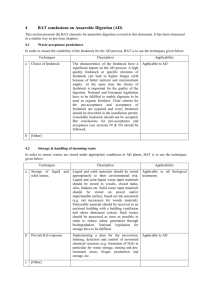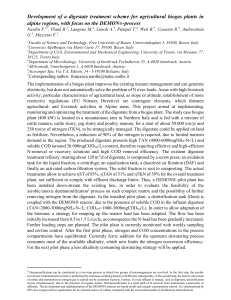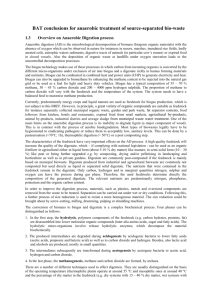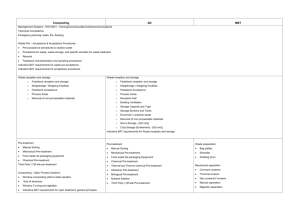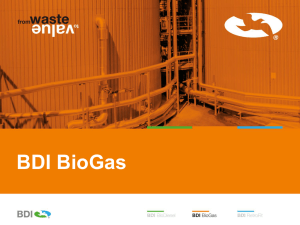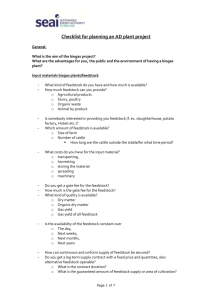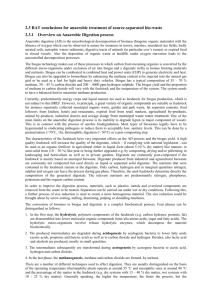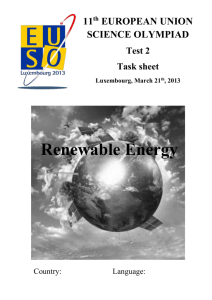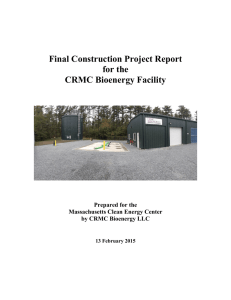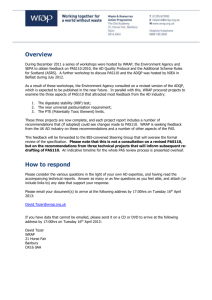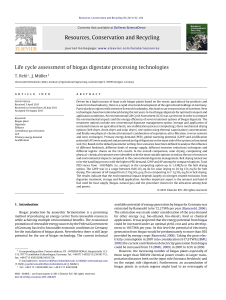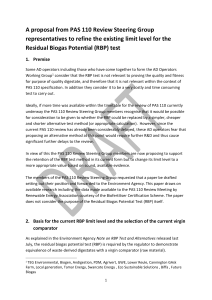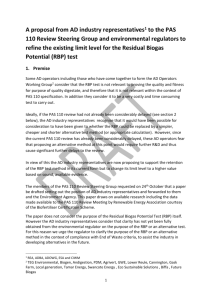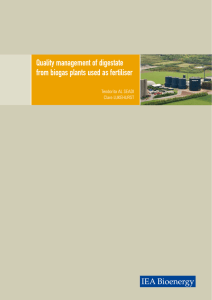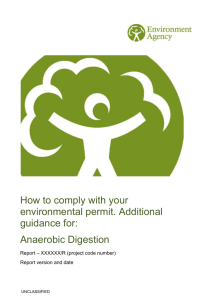Draft Best Available Techniques for AD
advertisement
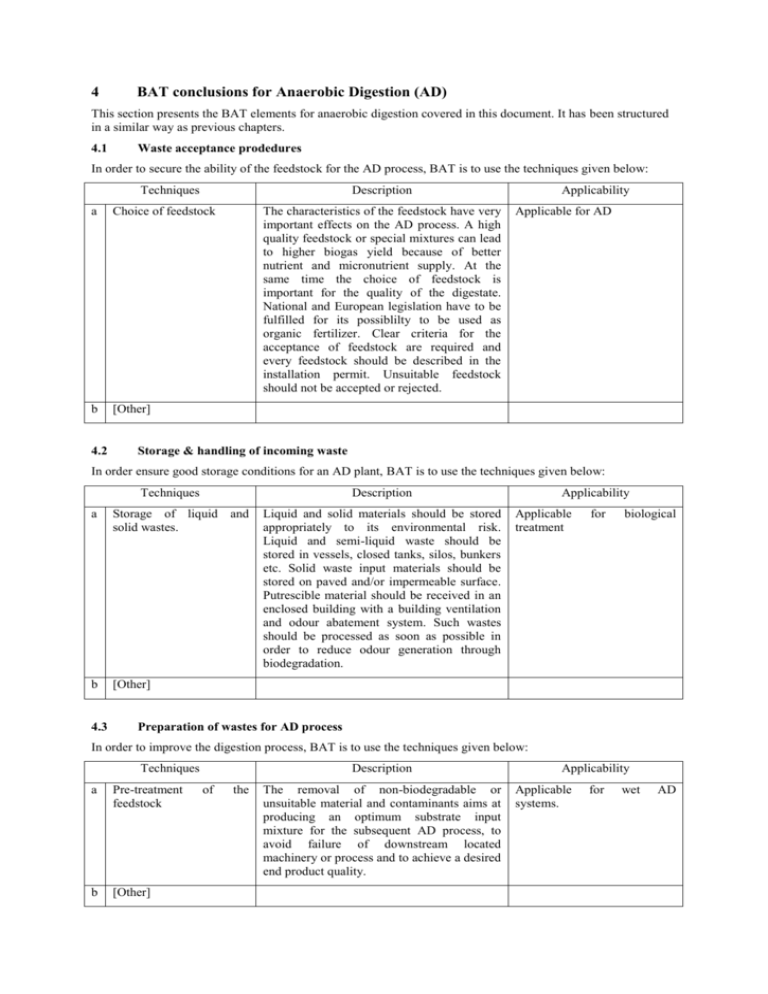
4 BAT conclusions for Anaerobic Digestion (AD) This section presents the BAT elements for anaerobic digestion covered in this document. It has been structured in a similar way as previous chapters. 4.1 Waste acceptance prodedures In order to secure the ability of the feedstock for the AD process, BAT is to use the techniques given below: Techniques Description a Choice of feedstock b [Other] 4.2 The characteristics of the feedstock have very important effects on the AD process. A high quality feedstock or special mixtures can lead to higher biogas yield because of better nutrient and micronutrient supply. At the same time the choice of feedstock is important for the quality of the digestate. National and European legislation have to be fulfilled for its possiblilty to be used as organic fertilizer. Clear criteria for the acceptance of feedstock are required and every feedstock should be described in the installation permit. Unsuitable feedstock should not be accepted or rejected. Applicability Applicable for AD Storage & handling of incoming waste In order ensure good storage conditions for an AD plant, BAT is to use the techniques given below: Techniques Description a Storage of liquid and solid wastes. b [Other] 4.3 Liquid and solid materials should be stored appropriately to its environmental risk. Liquid and semi-liquid waste should be stored in vessels, closed tanks, silos, bunkers etc. Solid waste input materials should be stored on paved and/or impermeable surface. Putrescible material should be received in an enclosed building with a building ventilation and odour abatement system. Such wastes should be processed as soon as possible in order to reduce odour generation through biodegradation. Applicability Applicable treatment for biological Preparation of wastes for AD process In order to improve the digestion process, BAT is to use the techniques given below: Techniques a Pre-treatment feedstock b [Other] Description of the The removal of non-biodegradable or unsuitable material and contaminants aims at producing an optimum substrate input mixture for the subsequent AD process, to avoid failure of downstream located machinery or process and to achieve a desired end product quality. Applicability Applicable systems. for wet AD 4.4 Process monitoring & control specific to AD Depending on the feedstock, the chosen AD system and use of the digestate, the process monitoring, control and performance is important for optimal AD conditions, BAT is to use the techniques given below: Techniques a Process control b and Applicability A suitable monitoring and controll system, both manual and instrumental, is essential to ensure stable reactor operation and to minimise operational difficulties. Applicable for AD Process performance Optimal mixing of substrate will enable running the digesters under optimal biological conditions. Applicable to wet and dry continuous AD systems c Measurement of temperature Constant temperature is very important for the microbiological milieu and has direct influence on biogas production and the hygienic status for the digestate. Applicable for AD d [Other] 4.5 monitoring Description Emissions to water The advantages associated with biogas production from biowaste include the production of digestate that commonly can be used as a fertiliser. During the closed AD process itself, there is no excess water; however waste water may appear during storage, pre- and post-treatment and side-activities or from surfaces. In order to reduce the waste water amount as well as the water consumption of AD plants, BAT is to use the techniques given below: Techniques Description a Reuse of waste water Waste water which appears during storage, pre- and post-treatment and side-activities or from surfaces can be collected and used in the AD process for adjusting the water content in the digester to reduce the total water consumption and the amout of waste water. Applicable for AD b Application of solid and/or liquid digestate as fertiliser In order to prevent or reduce emissions to water from anaerobic digestion plants, digestate is a valuable nutrient-rich fertiliser which should be applied for the nutrient demand of the plants, if national and European requirements are fulfilled. Applicable for AD c [Other] 4.6 Applicability Emissions to air The AD process itself is enclosed but air emissions and odour can occur during handling of incoming waste input material, transfer to and from the digester as well as open storage, separation, pre-treatment and mixing of biowaste e.g. with digestate as well as from open reactors or tanks and digestate conditioning and post-treatment. In order to prevent or reduce emissions from AD systems to air, BAT is to use the techniques given below: Techniques Description Applicability a Closed digestate storage with gas collection. Minimizing methane and ammonia emissions which may occur during open storage of insufficient stabilized digestate. Applicable storage. for digestate b Controlled postcomposting Emission form uncontrolled anaerobic processes during post-composting should be avoided by an adequate aeration step. Applicable post-composting of digestate. c Implementing control d AD plants can be controlled on fugitive emissions from pressure relief valves, poorly sealed water traps or condensate handling e.g. with IR camera. Applicable for AD Removal of sulphur In order to prevent or minimize sulphur emissions to air from the combustion of biogas by scrubbing biogas adding metal salts into the digester or internal or external biological oxidation by a controlled addition of oxygen. Alternatively or additionally the produced biogas can be cleaned of sulphur and if necessary also of siloxane with activated carbon filtration. Applicable biogas with high sulphur concentrations e Equipping AD plants with additional biogas storage and/or alternative biogas consumer If engines do not run, biogas which cannot be stored or used energetically elsewhere should be flared by a gas torch not to release methane in the atmosphere. Applicable for AD f [Other] 4.7 a leak- Measures of energy efficiency and reduction of raw material In case of AD plants, energy sources like electricity, fuel and heat, which are used during the normal operation of the installation, can be generated on-site and substitute fossil energy carriers. In order to increase the energy efficiency and to reduce raw materials, BAT is to use the techniques given below: Techniques Description Applicability a Using biogas as energy source Using biogas from AD in energy conversion apparatus, e.g. gas engines, gas turbines, boilers, vehicles is generally applied. The engines should not be undersized. Applicable for AD b Biogas maximisation Maximise the production of biogas and methane. This technique needs to consider the effect on the digestate and biogas quality. Applicable when the biogas yield is very low c Increasing the energy efficiency of CHP The efficiency of AD plants can be increase with modern combined heat and power units (CHP) with higher electrical conversion efficiencies. Applicable for AD d Using heat for external use Up to one third of the produced heat is needed to heat the digester itself, since the process requires warm conditions. Excess heat which is produced in CHP which can also be used for external heat users e.g. buildings, stables drying processes to increase the overall conversion (electrical and thermal) efficiency. Applicable for AD e Upgrading biomethane Biogas can also be upgraded to biomethane by enhancing the methane content to be injected into the natural gas grid or be used as a fuel for light and heavy duty vehicles. Applicable for AD without external heat use f Use of Additives For the optimization of the AD process and increasing the biogas yield, additives like trace elements and enzymes can be used in certain cases to offer nutrients for the microorganisms. Applicable for AD biogas to g 4.8 [Other] Product preparation and storage The produced digestate can placed on the market to substitute inorganic fertiliser. Techniques a [Other] Description Applicability
